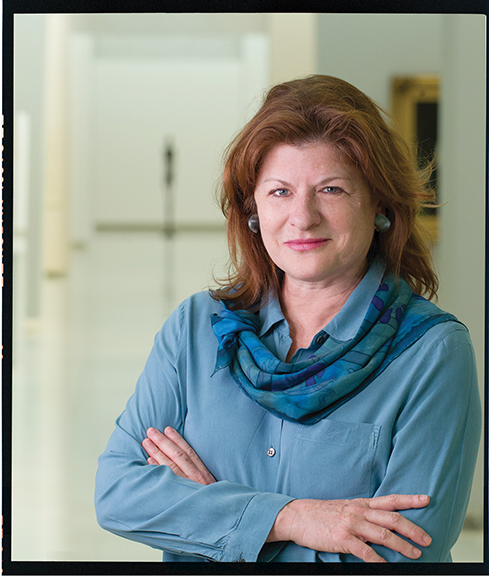 Summer 2014
Summer 2014|
Catherine Evans
Catherine Evans calls her career path “sort of accidental.” The native New Yorker grew up speaking Czech with her mother and soaking in the performing arts and museums thanks to her father, who at the time was the arts editor for The Wall Street Journal. She went on to study at Williams College, a top liberal arts school known for churning out arts leaders, where she got hooked on art history and spent a year in Germany. “I was a 17th-century Dutch maniac,” recalls Evans. But after spending three winters in Chicago working for an art dealer, she returned home to care for her mother, and there joined Seagram Corporation in Manhattan, coordinating art acquisitions and co-writing a book about the early days of architectural photography with Phyllis Lambert, the founder of the Canadian Centre for Architecture. That immersive experience led to an entry-level position at the Museum of Modern Art (MoMA), where she worked for a decade alongside the legendary John Szarkowski, the most notable curator of photography in the 20th century. “In lieu of grad school, it was my boot camp and master’s degree,” she says. Evans left that dream job for another once-in-a-lifetime opportunity—a family adventure in Brazil—before landing at Columbus Museum of Art, where she served as both chief curator and curator of photography, putting the museum on the map by acquiring its prized Photo League collection and stoking its reputation as an innovator in visitor engagement. Now she’s diving head first into another new, albeit unexpected, journey as chief curator of Carnegie Museum of Art. Midcareer, you had the chance through your husband’s work to move your family to Brazil. Did you jump at the prospect?It was very unexpected in that we had two little boys by that time, and up until that point living abroad to me meant Milan or Paris. We didn’t speak a lick of Portuguese, and São Paulo is an immense and daunting city. It was kind of trial by fire, and once we got a handle on the language life was great and we ended up staying five years. My daughter was born there. It was a terrific experience for the children to be steeped in another culture and to become bilingual. My mother was an immigrant who got out of Czechoslovakia right after the Second World War under very difficult circumstances. I had a kind of bifurcated upbringing with my Iowa-born father and my mother from Prague, so when we had an international opportunity with our children, I thought it was kind of in keeping with my experience. How did you end up in Columbus, Ohio?We were transferred there from São Paulo. As a sort of narrow-minded New Yorker, I went kicking and screaming, but it actually ended up being a truly wonderful place. I was very grateful to have an opportunity to work with the Columbus Museum of Art. It was a perfect fit at the time and reinvigorated my museum career. In this new role at Carnegie Museum of Art, you don’t oversee any one department or collection. Is that a big adjustment?I really welcome the challenge of being an advocate for all of the curators. I’ve had amazing opportunities to publish and do major exhibitions in my career and that was thoroughly rewarding, but I also find a lot of satisfaction in supporting a variety of projects. I’m encouraged by the broader institutional challenge of working with [museum director] Lynn Zelevansky to map out the next steps for developing a more visitor-engaged experience. What’s the biggest challenge in achieving that goal?It’s not something that happens overnight; it has to be intentional and strategic. And there has to be a certain willingness to make mistakes and learn from them. Columbus Museum of Art is now known for being visitor-focused. Did you play a role?From a curatorial perspective, I led the charge. I recently collaborated with my former colleagues for an article in the Journal of Museum Education about how we went down this path. I think it’s key to establish dialogue and forge a relationship between curators and educators. What we know from all kinds of studies is that to be sustainable and relevant museums have to shift to a more visitor-centered model. People come to museums for all sorts of reasons, with all sorts of expectations. Instead of thinking only about what we want visitors to know, how can we translate that knowledge, make it accessible and meaningful to a much wider audience? I come out of a very traditional working style and traditional museum structure, and I know how long it took me to come around to thinking in this new way, and how incredibly rewarding and transformative it’s been.
|
Andy Warhol, Revealed · Rockhound · Picture This · Small Prints, Big Artists · Special Section: A Tribute to Our Donors · Director's Note · NewsWorthy · About Town: A Legacy of Science · Artistic License: Home-field Advantage · Science & Nature: Big Blue · The Big Picture
 |
Copyright © 2017 CARNEGIE Magazine. All rights reserved. |

